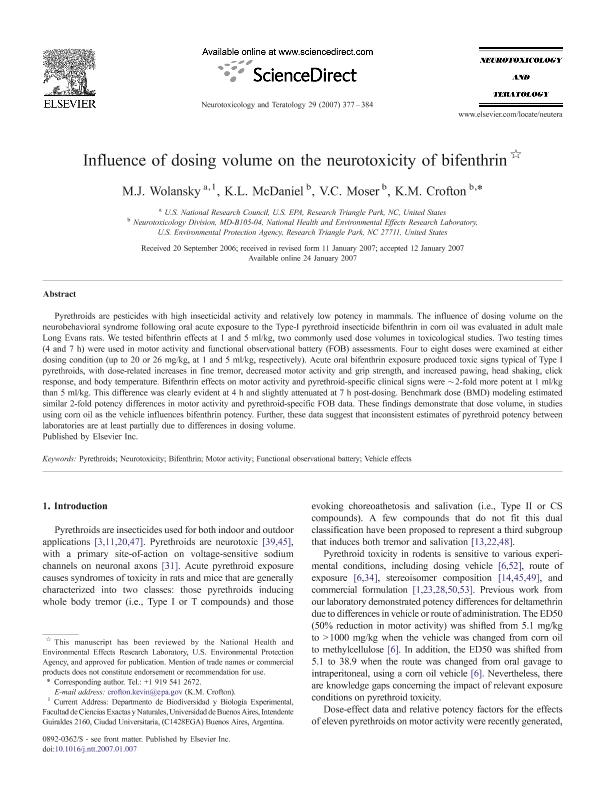Mostrar el registro sencillo del ítem
dc.contributor.author
Wolansky, Marcelo Javier

dc.contributor.author
McDaniel, K. L.
dc.contributor.author
Moser, V. C.
dc.contributor.author
Crofton, K. M.
dc.date.available
2020-01-09T20:15:29Z
dc.date.issued
2007-05
dc.identifier.citation
Wolansky, Marcelo Javier; McDaniel, K. L.; Moser, V. C.; Crofton, K. M.; Influence of dosing volume on the neurotoxicity of bifenthrin; Pergamon-Elsevier Science Ltd; Neurotoxicology and Teratology; 29; 3; 5-2007; 377-384
dc.identifier.issn
0892-0362
dc.identifier.uri
http://hdl.handle.net/11336/94207
dc.description.abstract
Pyrethroids are pesticides with high insecticidal activity and relatively low potency in mammals. The influence of dosing volume on the neurobehavioral syndrome following oral acute exposure to the Type-I pyrethroid insecticide bifenthrin in corn oil was evaluated in adult male Long Evans rats. We tested bifenthrin effects at 1 and 5 ml/kg, two commonly used dose volumes in toxicological studies. Two testing times (4 and 7 h) were used in motor activity and functional observational battery (FOB) assessments. Four to eight doses were examined at either dosing condition (up to 20 or 26 mg/kg, at 1 and 5 ml/kg, respectively). Acute oral bifenthrin exposure produced toxic signs typical of Type I pyrethroids, with dose-related increases in fine tremor, decreased motor activity and grip strength, and increased pawing, head shaking, click response, and body temperature. Bifenthrin effects on motor activity and pyrethroid-specific clinical signs were ∼ 2-fold more potent at 1 ml/kg than 5 ml/kg. This difference was clearly evident at 4 h and slightly attenuated at 7 h post-dosing. Benchmark dose (BMD) modeling estimated similar 2-fold potency differences in motor activity and pyrethroid-specific FOB data. These findings demonstrate that dose volume, in studies using corn oil as the vehicle influences bifenthrin potency. Further, these data suggest that inconsistent estimates of pyrethroid potency between laboratories are at least partially due to differences in dosing volume.
dc.format
application/pdf
dc.language.iso
eng
dc.publisher
Pergamon-Elsevier Science Ltd

dc.rights
info:eu-repo/semantics/openAccess
dc.rights.uri
https://creativecommons.org/licenses/by-nc-nd/2.5/ar/
dc.subject
BIFENTHRIN
dc.subject
FUNCTIONAL OBSERVATIONAL BATTERY
dc.subject
MOTOR ACTIVITY
dc.subject
NEUROTOXICITY
dc.subject
PYRETHROIDS
dc.subject
VEHICLE EFFECTS
dc.subject.classification
Toxicología

dc.subject.classification
Medicina Básica

dc.subject.classification
CIENCIAS MÉDICAS Y DE LA SALUD

dc.title
Influence of dosing volume on the neurotoxicity of bifenthrin
dc.type
info:eu-repo/semantics/article
dc.type
info:ar-repo/semantics/artículo
dc.type
info:eu-repo/semantics/publishedVersion
dc.date.updated
2019-11-25T19:14:38Z
dc.journal.volume
29
dc.journal.number
3
dc.journal.pagination
377-384
dc.journal.pais
Países Bajos

dc.journal.ciudad
Amsterdam
dc.description.fil
Fil: Wolansky, Marcelo Javier. Consejo Nacional de Investigaciones Científicas y Técnicas; Argentina. U.S. National Research Council; Estados Unidos
dc.description.fil
Fil: McDaniel, K.L.. U.S. Environmental Protection Agency; Estados Unidos
dc.description.fil
Fil: Moser, V.C.. U.S. Environmental Protection Agency; Estados Unidos
dc.description.fil
Fil: Crofton, K.M.. U.S. Environmental Protection Agency; Estados Unidos
dc.journal.title
Neurotoxicology and Teratology

dc.relation.alternativeid
info:eu-repo/semantics/altIdentifier/url/https://www.sciencedirect.com/science/article/pii/S0892036207000104
dc.relation.alternativeid
info:eu-repo/semantics/altIdentifier/doi/http://dx.doi.org/10.1016/j.ntt.2007.01.007
Archivos asociados
